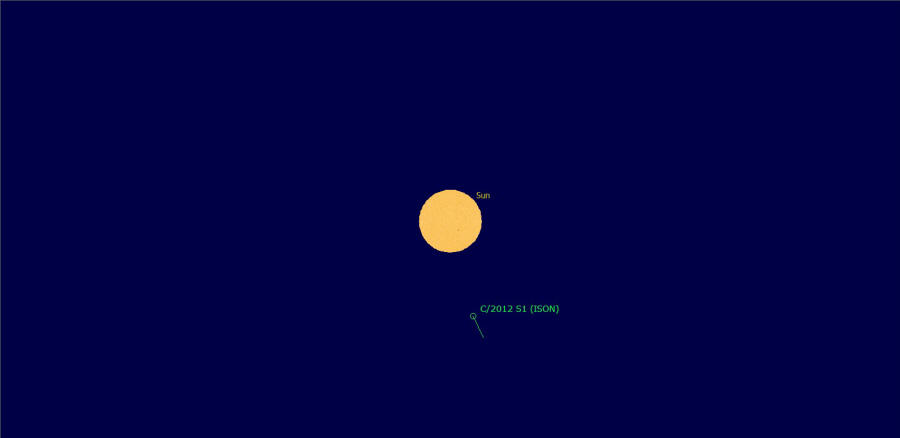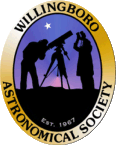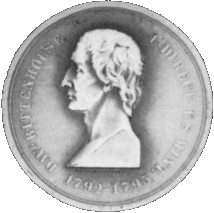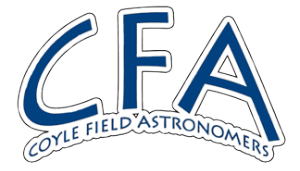The Crescent Moon and Mercury
After sunset on February 1, 2014, the 49.5-hour-old Crescent Moon, with prominent earthshine, was 10° above the planet Mercury, which in turn was at 7° altitude (near the bottom of the frame, mouseover for label). Both objects were in the zodiacal constellation Aquarius, the Water Bearer; Lambda Aqr is to the left of the moon, while Eta, Zeta and Gamma Aqr (in the Water Jar) are to the right of the moon. This image was captured at 6:10 pm EST from a shopping center parking lot on Rt 130 in Delran, NJ, with a Canon 6D digital SLR camera (on a fixed tripod) and a Canon 100 mm, f/2.8L macro lens. It was exposed 0.6 seconds at f/4, ISO 800.
Comet Lovejoy on New Year's Day 2014
On New Year's Day, January 1, 2014, Comet C/2013 R1 (Lovejoy), located in the constellation Hercules, was observed at Atsion Field in Wharton State Forest, NJ, from about 5:00 to 5:45 am EST. Astronomical twilight started at 5:43 am, while new moon was at 6:14 am. Unfortunately, clouds started moving in not long after arrival, and it was almost completely overcast on departure (some cloudiness is evident in this picture). With 16x70 binoculars, the coma of Comet Lovejoy was not as prominent as M13, but it was comparable to M92. Judging from the 4-degree field of the binoculars, the faint tail was about three-quarters of a degree long. The picture above is a single frame taken at 5:27 am EST with a Canon EOS 6D digital SLR camera (on a fixed tripod) and a Canon EF 100 mm f/2.8L Macro IS USM lens. It was manually exposed 6 seconds at f/4, ISO 6,400. The field of view is about 20° wide x 14° high, and stars to around magnitude 9 are visible here, but about magnitude 10 before size reduction. In addition, Comet C/2012 X1 (LINEAR) was spotted with the 16x70 binoculars as a faint smudge near 29 Herculis (about 4½° outside the upper-right edge of this image). Mouseover for labels.
Crescent Venus
This is Venus at 5:25 pm EST on December 27, 2013, when it was less than 15 days from inferior conjunction, which is at 7:24 am EST on January 11, 2013. The 57 arc-second diameter disc of Venus was a 7% illuminated crescent at 10° altitude in the southwest, 43 minutes after sunset. The low altitude results in the thin crescent being distorted into a banana-like shape (the appearance was much the same visually in the scope). Taken with a Canon EOS 6D digital SLR camera at the prime focus of a William Optics 80 mm, f/6 apochromatic refractor. Exposed 1/1250 second at ISO 1600. This frame was cropped to approximately one-eighth the original size.
Comet Lovejoy on Christmas Day 2013
On Christmas morning, December 25, 2013, Comet C/2013 R1 (Lovejoy) was observed near Delta Herculis at Atsion Field in Wharton State Forest, NJ, from about 5:00 to 5:45 am EST. Astronomical twilight started at 5:41 am, a few hours before the moon reached Third Quarter at 8:48 am. SkyTools indicated it was at magnitude 5.7, but because of the moon, it was not visible to the unaided eye (neither was the nearby similar-magnitude globular cluster, M13). However, it was a fine view in 16x70 binoculars with a pale greenish head and a visible tail that extended almost a degree. The picture above was taken at 5:26 am EST with a Canon EOS 6D digital SLR camera (on a fixed tripod) and a Canon EF 40 mm f/2.8 STM lens. It was manually exposed 4 seconds at f/4, ISO 6,400. The image below is a crop of the area around Comet Lovejoy in the image above. The tail of Lovejoy extends to the upper-left of the coma, and the view below is much like the binocular view. The double star 45 arc minutes above the coma has a separation of 3 arc minutes. Mouseover for labels.
Sundog, December 7, 2013
This Sundog was captured at 4:05 pm EST on December 7, 2013, from Swede Run in Moorestown, NJ, with a Canon PowerShot SD1000 Digital Elph point-and-shoot camera. It was exposed 1/400 second at f/8, ISO 80, 6 mm focal length.
Young Moon, December 3, 2013
New moon occurred on December 2, 2013, at 7:22 pm EST, so the thin crescent was only 21 hr 37 min old when this picture was taken on December 3, 2013, at 4:59 pm EST, 24 minutes after sunset. The sliver of moon was initially spotted with 16x70 binoculars at 4:55 pm (21 hr 33 min old, 6° altitude), then once located, it was seen with unaided eyes. When the picture was taken, the moon was at 5½° altitude, and it was followed until 5:15 pm when it was at 3° altitude. Conditions were not ideal as there was murky haze along the horizon; nevertheless, the ultra-thin rim of light (encompassing just a quarter to a third of the moon's circumference in this case) is one of the most sublime of heavenly sights. Canon 6D digital SLR camera with a Canon 70 to 200 mm f/2.8L zoom lens at 200 mm focal length. Exposed 1/160 second at f/3.2, ISO 1000, handheld. Cropped to about one-fifth of the original linear frame size.
Comet ISON at Perihelion
On Thursday, November 28, 2013, Comet C/2012 S1 (ISON) will reach perihelion around 1:40 pm EST at a distance of only about 724,000 miles. The resultant intense solar heating might produce exceptional brightness and the comet's head may be visible in the daytime. Click here for a series of diagrams similar to the one above showing ISON at half-hour intervals through the day (the diagram above is at noon on Thursday, for an observer looking towards the sun, zenith up; the sun is to scale at 32.4 arc minutes diameter). Even if it becomes visible, it will be a difficult observation, probably requiring binoculars, and best suited for those with experience spotting objects (such as Venus) near the sun. In any case, extreme caution is necessary to avoid eye damage from glimpsing the sun (it needs to be blocked behind a structure). Update: There were no reports of a visual sighting on perihelion day, and in fact, Comet ISON appears to have dissipated from from its close brush with the sun.
Minotaur Launch from Wallops
On November 19, 2013, a Minotaur I rocket was launched from the Wallops Flight Facility in Virginia. It carried the DoD's ORS-3 mission, along with a number of CubeSats, to orbit. This picture of the rocket's trail was captured from Borton Landing Rd in Moorestown, NJ, using a Canon 6D digital SLR camera and a Canon 24-105 mm f/4L zoom lens at 24 mm focal length. It was exposed 61 seconds at f/8, ISO 400, 4000K color balance (besides size reduction for this page, no adjustments were made). The bright star above the left end of the trail is Beta Ceti (Diphda or Deneb Kaitos) at 32° altitude, 172° azimuth. The stars in a zig-zag pattern on the left are (from top to bottom) Epsilon, Delta, Pi and Gamma Eridani. Epsilon is at 23° altitude and 125° azimuth. Beta Ceti and Epsilon Eridani are about 42° apart. Mouseover for the next segment of the rocket trail, same exposure as above. The initial image was time stamped 8:15:59 pm EST, the second 8:17:04 pm EST (the camera's clock was set by its internal GPS). The increased brightness of the foreground weeds in the second image is due to headlights from a passing car. The landlocked "USS Rancocas" is just outside the frame on the left.
The image below is a significant crop of the third frame showing the continuing left end of the trail shown in the mouseover image above. Near the beginning of the 61-second exposure, the rocket exhaust tapers off and fades away (engine shutdown), and no further stages were seen. Same setings as the previous two images; time stamped 8:18:10 pm EST. The zig-zag of Epsilon, Delta, Pi and Gamma Eridani is visible to the left of the trail.
Mercury Update - November 2013
Following the string of Mercury sightings for each of its six elongations in 2012, I've decided to continue spotting Mercury at each of its six elongations for 2013. The initial sighting for each elongation is tabulated below:
|
Sequence |
Initial Sighting Date (2013) |
Observing Location |
Greatest Elongation (UT) |
|
#1 |
February 1, 5:40 pm EST | Baseball Fields, Maple Shade, NJ |
February 16, eastern (evening) |
|
#2 |
March 22, 6:15 am EDT | Pennsauken Mart Site, NJ |
March 31, western (morning) |
|
#3 |
May 20, 8:17 pm EDT | Rt 130 at Creek Rd, Delran, NJ |
June 12, eastern (evening) |
|
#4 |
July 27, 5:00 am EDT | Pennsauken Mart Site, NJ |
July 30, western (morning) |
|
#5 |
September 13, 7:23 pm EDT | Swede Run, Moorestown, NJ |
October 9, eastern (evening) |
|
#6 |
November 11, 5:30 am EST | Coyle Field, Woodland Twp, NJ |
November 17, western (morning) |
The first sighting in February, and for 2013, was accomplished with an 80 mm, f/6 apo refractor and a 35 mm Panoptic eyepiece (14x, 4.6° field of view). The first sighting in March used 16x70 binoculars (4° field of view). The first sighting in May (a few degrees from Venus) was accomplished with 10x42 binoculars (5° field of view). The first sighting in July (about 8° below Jupiter and Mars) was through 16x70 binoculars, then glimpsed with unaided eyes. The first sighting in September was through 16x70 binoculars, about 25° west of Venus. The first sighting in November was made with unaided eyes (after spotting four comets in the previous hour or so); although at a low altitude with poor seeing, when observed through a 12.5-inch Newtonian at 160x with a red filter, a banana-like disc was noted (Mercury was 30% illuminated). The current sighting streak is now 19 elongations in a row, or three complete years, 2011 through 2013.
Click here for some older images.




